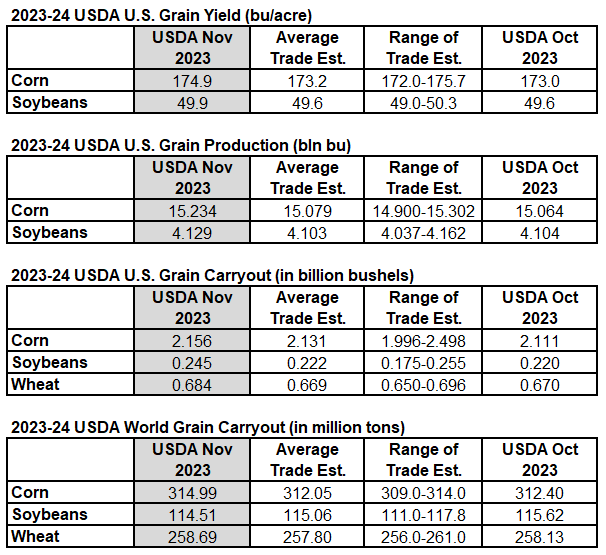Traders react bearish to USDA numbers
Corn
The USDA raised their US corn yield estimate by nearly 2 bushels, increasing their estimate from 173.0 to 174.9 bpa from October to November.
The USDA raised the 2023 US corn production to a record 15.234 billion bushels, up from 15.064 billion last month, and the average trade estimate of 15.079 billion.
Corn ending stocks for next fall were estimated at 2.156 billion bushels, up from 2.111 billion last month, and the average trade guess of 2.131 billion bushels.
Corn is in a 4-Box Buy Signal. Livestock producers should be purchasing feed.
Soybeans
The USDA bean yield was also increased, moving to 49.9 bpa from 49.6 bpa last month.
The USDA soybean production estimate was pegged at 4.129 billion bushels, up from 4.104 billion last month.
Soybean carryover increased to 245 million bushels, compared to 220 million bushels last month, and the average trade estimate of 222 million bushels.
Wheat
US wheat carryout for next July increased to 684 million bushels, compared to 670 million last month and the average trade estimate of 669 million bushels.
Thoughts
These numbers were not enough to change anybody?s opinion about supply and demand. Maybe the corn number increased enough to make a little difference there, but what is much more important is the weather down in Brazil, war in the Black Sea region, and global political uncertainty.
Right now, we believe the soybean market is up on a peak due to South American weather worries, a big round of Chinese business, and commodity fund buying. We were thankful to get the soybean Selll Signal this week and hope you were able to sell the beans you needed. That being said, we look for higher prices next year on beans, unless the Brazilian weather stages a change for the better.
The wheat prices have been beaten down for weeks because offers out of Ukraine and Russia have been discounted below other world offers. In addition, commodity funds have built large net short positions. Wheat markets are way overdue for a bounce. When wheat prices move solidly above the 20-day moving average, we should get very active fund buying and a boost in price. Or as we saw this week, if ships are attacked, prices rally.

Source: USDA, Reuters, StoneX
